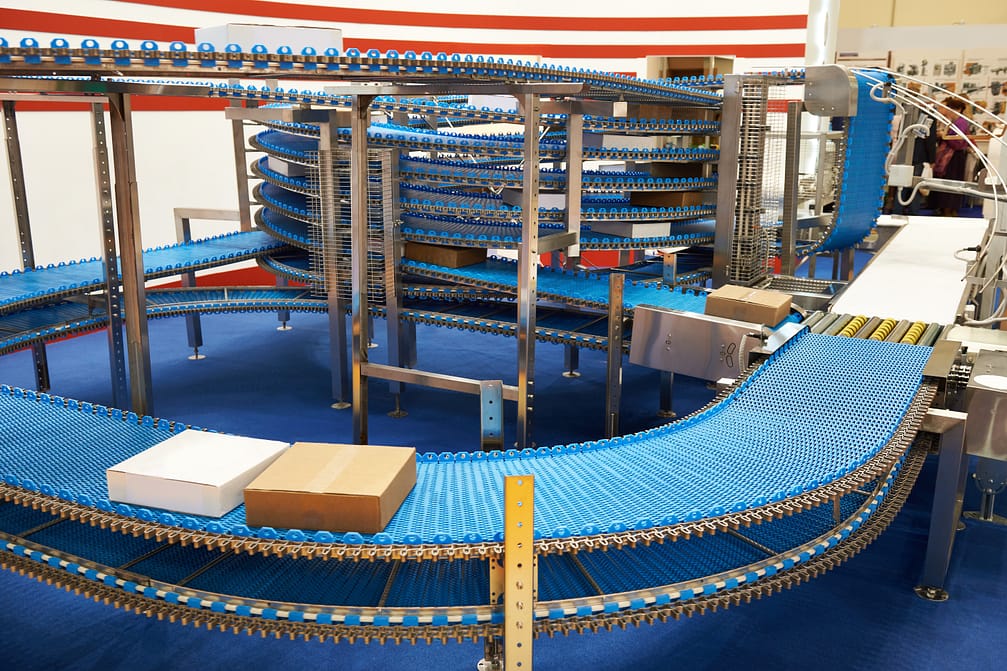The equipment may also move products in a distribution center picking point to a loading dock. Moreover, a conveyor may be necessary to move finished products into a truck for delivery.
There are as many types and configurations of conveyor systems as there are uses. Conveyer and Caster’s Total Material Handling Solutions design, produce and install any conveyor configuration to expedite product movement, whether as individual units or cases to fully loaded pallets and totes.
Conveyors for Any Application
 Conveyors may be simple inertia and gravity-operated or more complex, powered systems that move heavy loads from one part of a process to another. Simple conveyors may utilize “skate wheels” or rollers to move smaller units or boxes. Sometimes these types of units transfer products from a single workstation to another. Moreover, these can assist the transfer of products from the delivery truck into a storage room or onto a dock. Quick delivery and placement save time and money for the customer and the supplier.
Conveyors may be simple inertia and gravity-operated or more complex, powered systems that move heavy loads from one part of a process to another. Simple conveyors may utilize “skate wheels” or rollers to move smaller units or boxes. Sometimes these types of units transfer products from a single workstation to another. Moreover, these can assist the transfer of products from the delivery truck into a storage room or onto a dock. Quick delivery and placement save time and money for the customer and the supplier.Powered conveyors add considerable flexibility to manufacturing and supply chain management. Properly designed belt conveyors, working at a controlled speed, can bring the goods to their destination at a predetermined time to allow for a smooth manufacturing or supply chain transition.
Powered Conveyor Applications in Industry
With today’s highly automated warehousing systems, conveyors perform many of the functions that people and forklifts have carried out in the past. Instead of requiring someone to travel to a pallet position or slot to retrieve a pallet or individual product, computerized systems can automatically “pick” a bar-coded unit, transfer it to a powered, computer-controlled belt conveyor system and deliver to the loading area at the right time and the correct position to load for delivery. This type of system is becoming more common, reducing the costs of labor and real estate while eliminating inefficiencies.One recognizable application of motorized conveyor systems is the baggage claim network at modern airports. Once the cargo and luggage are removed from the airplanes by conveyor, the bar-coded items filter through a system that sorts each piece for a transfer to a connecting flight or the baggage claim.

Types of Conveyors
Conveyors solve thousands of product movement challenges. Selecting the right one depends on the kind of materials, maximum weight, and the speed and delicacy that is required.Belt conveyors are mostly motor driven, turning a shaft that rotates the belt. The motor is controlled by a computer or manually adjusted to adjust the speed to the output. The belt may be made from a variety of materials such as rubber, plastic, or metal, depending upon the product to be handled.
Roller conveyors are appropriate for some types of products. On a larger scale, most pallet conveyors tend to be roller-types, since the pallets are both large and regularly shaped. Motorized roller conveyors sometimes work with only one motorized roller in a zone to propel the products along while the rest of the rollers maintain the momentum. These systems can be designed to shut off when a sensor determined that no product is approaching.
Consult with the Experts
Conveyer and Caster in Cleveland, Ohio, has been providing materials handling solutions for over 50 years. Conveyer & Caster recognizes that each company has different needs and can provide creative solutions for manufacturing and distribution challenges.
Information in this article is based on content from Modern Materials Handling
Keep up with us!
Stay up to date on the latest industry news and our work at Conveyer & Caster – Equipment for Industry by subscribing to our blog








